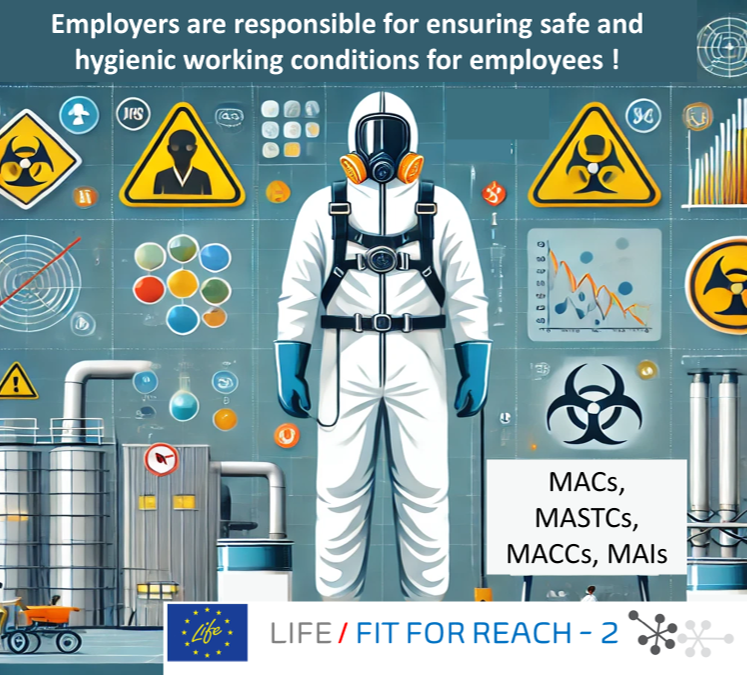
Exposure to harmful factors at work can negatively affect workers’ health. Therefore, it is crucial to adhere to the applicable regulations. Through proper protection of health and life in hazardous working conditions, it is possible to reduce the occurrence of occupational diseases and workplace accidents.

Employers are responsible for ensuring safe and hygienic working conditions.
One of the elements of protecting workers from the negative effects of harmful factors is adhering to the established permissible occupational exposure levels for health-hazardous factors, known as hygienic norms. These norms are based on scientific data regarding a specific harmful factor and its health effects.
Hygienic norms have been defined for harmful chemical and dust factors present in the work environment (expressed by the maximum allowable concentrations – MACs, maximum allowable short-term concentrations – MASTCs, and maximum allowable ceiling concentrations – MACCs), as well as harmful physical factors (expressed by maximum allowable intensities – MAIs) . All these terms are defined in the Regulation of the Minister of Family, Labor, and Social Policy of June 12, 2018, regarding the maximum permissible concentrations and intensities of harmful factors for health in the work environment (Journal of Laws 2018, item 1286, as amended):
- MACs – Time-weighted average concentration, the impact of which on a worker during an 8-hour workday and a weekly work schedule, as defined by the Labor Code, should not cause negative health changes for the worker or future generations over their professional career.
- MASTCs – Short-term average concentration that should not cause adverse health changes if present in the work environment for no more than 15 minutes and no more than twice during a shift, with an interval of at least one hour.
- MACCs – A concentration that, due to health or life risks, must not be exceeded at any time in the work environment.
- MAIs – The highest permissible intensity of a physical harmful factor for health, established as exposure levels that should not cause adverse health effects for workers or their future generations throughout their professional career.
In Poland, the system of setting MACs, MASTCs, MACCs, and MAIs values has been in place since 1983. The main body responsible for this is the Interministerial Commission for Maximum Allowab le Concentrations and Intensities of Harmful Factors for Health in the Work Environment, appointed by the Prime Minister. Members of this commission develop proposals for hygienic norms based on expert documentation, considering health criteria and risk assessment. These proposals are submitted to the Minister of Family, Labor, and Social Policy. Once approved, the maximum allowable concentrations and intensities are published in the Official Journal of the Republic of Poland in the form of a regulation. These values are legally binding for all sectors of the national economy .
Currently applicable MACs, MASTCs, and MACCs values are included in the annex to the July 2024 regulation of the Minister of Family, Labor, and Social Policy from June 24, 2024, amending the regulation on maximum permissible concentrations and intensities of harmful factors for health in the work environment (Journal of Laws 2024, item 1017). This annex replaces Annex 1 to the June 12, 2018, regulation and has been in force since August 10, 2024, except for positions listed in §2 of the regulation, which have different effective dates. One example is the popular preservative “Post-reaction mass of 5-chloro-2-methyl-2H-isothiazol-3-one and 2-methyl-2H-isothiazol-3-one (3:1)” (CAS 55965-84-9), for which the MACs and MASTCs values take effect from April 5, 2024. The MAIs values have not been changed in the June 24, 2024, regulation, meaning that the MAIs values listed in Annex 2 of the June 12, 2018, regulation remain in effect.
Would You like to find out how our project can help You with REACH – fill in the form and we will contact You shortly: https://forms.gle/ySzqcv6mKmCeb7Sx7
References
- Sylwia Oziębło-Brzykczy, „Normatywy higieniczne w środowisku pracy. Ważne NDS i NDN. Poradnik dla Pracodawców”, Państwowa Inspekcja Pracy, Główny Inspektorat Pracy, Warszawa 2024 (https://www.pip.gov.pl/publikacje/publikacje-dla-pracodawcow/normatywy-higieniczne-w-srodowisku-pracy);
- Centralny Instytut Ochrony Pracy – Państwowy Instytut Badawczy, Wartości dopuszczalne NDS/NDN czynników szkodliwych dla zdrowia w środowisku pracy, https://www.ciop.pl/CIOPPortalWAR/appmanager/ciop/pl?_nfpb=true&_pageLabel=P60600429261644998699865
